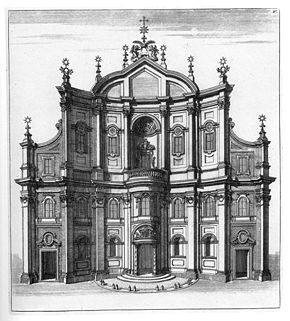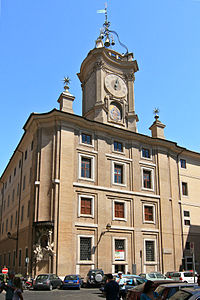- Oratorio dei Filippini
-
The Oratorio dei Filippini (Oratory of Saint Phillip Neri) is a building located in Rome and erected between 1637 and 1650 by Francesco Borromini. He belonged to the Congregation of the Oratory, founded by Philip Neri in 1561. It was there that, in 1600, Emilio de' Cavalieri's La rappresentazione di anima e di corpo, regarded as one of the first examples of the genre of the oratorio, was given for the first time.
The oratory of Filippini is adjacent to the Chiesa Nuova, the mother church of the congregation. In front of the two sides was a small closed square, now integrated in the Corso Vittorio Emanuele II.
Contents
History
The congregation of the Filippini already had one of the most well-decorated Baroque churches in Rome, and the order, so enthralled by the piousness encouraged by music, had planned to build an oratory, as well as a residential quarters, adjacent to the church of Santa Maria in Vallicella (Chiesa Nuova) located in crowded central Rome. Borromini won a competition for designing the structure against many including Paolo Maruscelli. He was employed in the task for 13 years, often a testy process. By 1640, the oratory was in use, by 1643, the library was complete.
Description
The striking facade adjacent to the church entrance has little regard for the structures behind. Inside the oratory is articulated by half columns and a complex rhythm of pilasters.
The facade provides a summary of Borromini's characteristics of innovations style, both austere and technically rigorous. The main body is divided into five parts by pilasters following a concave curve. In the central part, a dialectic set appears between the lower level, whose curve moves outward. At the top, the tympanum, created for the first time after an mistiligne angle, accentuates the both curved and angular movement.
At the corner of the oratory, on the Piazza dell'Orologio, Borromini raised a turret with a clock (1647-1649).
Bibliography
- Anthony Blunt, Vita e opere di Borromini, Laterza, Rome-Bari, 1983
- Paolo Portoghesi, Francesco Borromini, Elemond-Electa, Milan, 1990
References
- This article incorporates information from the revision as of 2009-06-29 of the equivalent article on the French Wikipedia.
Coordinates: 41°53′54″N 12°28′07″E / 41.898228°N 12.468710°E
Categories:- Roman Baroque
- Baroque sites of Lazio
- Roman Catholic churches in Rome
Wikimedia Foundation. 2010.



